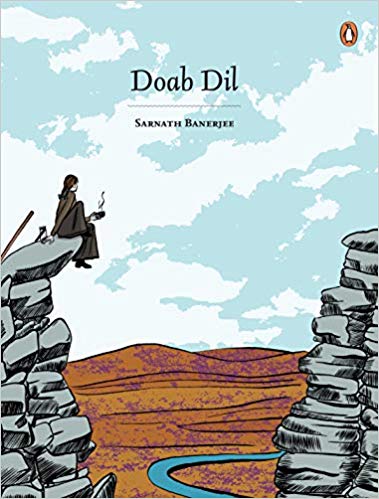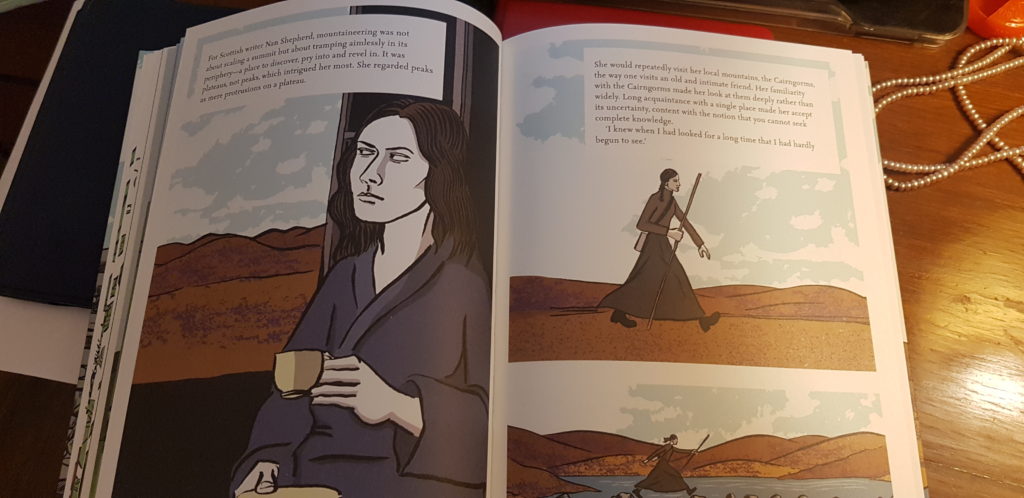Interview with Sarnath Bannerjee on “Doab Dil”
Graphic novelist Sarnath Bannerjee’s Doab Dil is an extraordinary piece of writing or “faction” as he would like to call it. It is based on a few years of intense reading with a panel, sometimes a double panel, dedicated to a writer – fiction, non-fiction, or even a lyricist. It is an “extraordinary” book for every time you flip through it there is something more to discover. The selection of the writers with the brown drawings is like entering an accessible portal for a walk through a history of reading. A reading that is a combination of the canonised writers along with the lesser known. It is like browsing through the bookshelves at a library where the familiar writers are placed with the lesser known names. Sarnath Bannerjee is known for his graphic novels Corridor, The Barn Owl’s Wondrous Capers, The Harappa Files, and All Quiet in Vikaspuri. Yet Doab Dil is a pivotal piece of work as it marks a transition from his early works to something new and exciting to come. It is to be found as he mentions, in the “spaces between the text and images form the central backbone of the book”.
Here is an extract from Sarnath Bannerjee’s introduction to the book:
…I was commissioned ninety murals for the new Deutsche Bank building at Canary Wharf, London. The curators, Alastair Hicks and Mary Findley, gave me an open brief, which is always a scary thing. After struggling through many meetings at Winchester House, we finally came up with the idea of making the whole building read like a book. Two years of intense reading suddenly came into sharp focus. This was my chance to archive my readings, to put my thoughts into drawings and, in doing so, preserve the books in my mind.
Doab Dil brings together drawings and text like two converging rivers. The fertile tract of land lying between two confluent rivers is called a doab (Persian do ab, two rivers). It is a rich, draught-free, populous tract where civilizations are born. These spaces between the text and images form the central backbone of the book. I have used bits of text that I have assimilated from my reading and mixed them with my own writing and interpreted them through drawings.
It is not surprising that authors find it easier to talk about reading than writing. Doab Dil is written in that spirit – a book by one reader to another.
******
Here is a lightly edited interview with Sarnath Bannerjee via e-mail.
JBR: Why and how was Doab Dil conceptualised? How long did it take to be made?
SB: Doab Dil is a book about reading than writing. A kind of deep and slow reading that produces wayward thoughts. Often reading provides a springboard for ideas, places and characters. It opens up one’s imagination beyond the merely personal.
There are some themes that Doab Dil explores. Gardens as places of enquiry as well as places where class and taste are played out. Dark Arcadias. Utopia and Suburbia. Originally the book was called “Common Utopias”. Sections of the book also look at work, enlightenment, history and end with a few popular songs that echo the theme of the book.
It took a couple of years to write and draw and many years of reading.
JBR: You refer to the Olympic Games project in the introduction but I am unable to see how the two are connected except for the book concept?
SB: The end product for both the projects have been large murals, they were drawn with expanse and detail in mind. The drawings themselves are self-contained and often tell parallel stories. This is the formal connection between the two works.
Some of the characters that appear in Doab Dil seem to be distant cousins of the characters that appear in my Olympic project. In both these, I have tried to practice the discipline of the unsaid. I have used minimal text but tried to expand the scope of the theme. In successful cases, the frugal text has brought out details and complexity of a larger tonal universe.
JBR: What made you switch to non-fiction reading?
SB: It wasn’t a conscious choice and i haven’t switched to non-fiction. Every now and then I stumble upon a good non-fiction book, I start reading it reluctantly and slowly get drawn into it. It just is not my first preference. Information and facts don’t interest me so much. Neither does opinions. But i have a great appetite for imagination. Imagination is proper therapy to get through life. If i need to know about something, like a city or a political event, i look for fiction around the theme.
Ever since I started working on my History Biennale project six years back. I have been reading a lot of books on rhetoric and history. That’s how it started. Also, many of my academic friends are converting their thesis into books, that gives me a steady stream of books to read.
JBR: Which was the first nonfiction book you read that got you hooked and spurred on this reading spree?
SB: The Little History of the World by Ernst Gombrich, Cheese and Worms by Carlo Ginzburg, Mumbai Fables by Prof Gyan Prakash etc.
JBR: In Doab Dil what came first — the text or the illustrations?
SB: At first came reading, then pictures then the writing.
JBR: “Doab Dil” are two Hindustani words but the text is in English. Would you like to see this book translated into Urdu or Hindi?
SB: I would very much like to, I don’t like the fact that my books are only in English. I would most love to write in Bengali. I have a good sense of the language, but I am not yet confident about writing in Bengali although I believe an app exists that will help me in this task.
JBR: These read like meditative pieces on literature irrespective of form. You glean tit-bits from modern classics to contemporary pop across nations and cultures but they all work together beautifully. How did you make your selections?
SB: I think I have my mother’s instinct. Or so I think. I have work intuitively. I don’t think I am very clever about structure and nor do I have a head for analysis. I am mostly driven by a kind of reportage.
JBR: What has been the reception to this book?
SB: Honestly, I have no idea.
30 May 2019



























